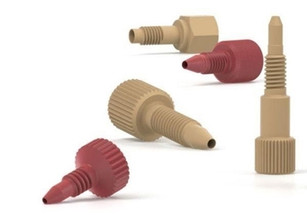Posted by Chrom Tech on 15th Oct 2025
How To Make an HPLC Connection With PEEK Tubing
Making an HPLC Connection With PEEK Tubing
Creating a proper HPLC connection is essential for ensuring leak-free performance and consistent chromatographic results. With PEEK (Polyetheretherketone) tubing, the process is straightforward and reliable when the correct fittings and techniques are used. Here’s how to make a secure connection using fingertight fittings:
- Slide the nut onto the tubing that will be inserted into the port.
- Place the ferrule onto the tubing just below the nut—ensure that the tapered edge of the ferrule faces away from the nut for high-pressure connections.
- Insert the tubing into the receiving port until it is firmly seated at the bottom.
- While holding the tubing in place, finger-tighten the nut completely until secure.
These simple steps create a strong, leak-free connection suitable for most analytical HPLC systems. For more complex configurations or high-pressure applications, continue reading below for additional guidance.
Why Use PEEK Tubing in HPLC?
PEEK tubing has become a mainstay in modern chromatography labs thanks to its durability, flexibility, and outstanding solvent compatibility. It resists nearly all commonly used HPLC solvents while offering excellent pressure tolerance—typically up to 6,000 psi depending on the tubing size and wall thickness. PEEK is also easy to cut and inexpensive to replace, making it a practical choice for both analytical and preparative HPLC systems.
Understanding HPLC Fitting Systems
An HPLC connection is typically made using a compression fitting system consisting of two parts: a nut and a ferrule. The nut provides the force needed to secure the ferrule, while the ferrule grips the tubing, forming a tight seal inside the receiving port. Some fittings integrate both parts into a single molded body for convenience—reducing small parts that can easily be dropped or misplaced during setup.
The Function of HPLC Fittings
- Prevent liquid leakage along the system’s flow path
- Securely hold tubing in place under system pressure
Making High-Pressure HPLC Connections With PEEK
High-pressure areas of an HPLC system (typically 4,000–6,000 psi) require extra care to ensure a secure, leak-free connection. These areas include tubing between the pump and the column or detector. Because system stress increases with pressure, properly assembled connections are critical for trouble-free operation and reproducible chromatographic results.
Why Choose FingerTight Fittings?
FingerTight fittings are polymer-based fittings that provide a secure seal without the need for tools. They don’t permanently adhere to the tubing, making them easy to reposition and reuse. To select the correct FingerTight fitting for your PEEK tubing, consider these key parameters:
- Tubing outside diameter (OD): Determines which fitting will provide the proper grip on the tubing wall.
- Receiving port material: The port should be made from a material at least as hard as the fitting to ensure a reliable seal.
- Threading and geometry: Confirm that the fitting matches the threading type (e.g., 1/4-28 or 10-32) and shape of your port.
Once you have selected the correct nut and ferrule for your system, making the connection is simple:
- Slide the nut and ferrule onto the tubing with the tapered edge facing away from the nut.
- Insert the tubing into the receiving port until it contacts the bottom of the port.
- Hold the tubing in place and tighten the nut firmly by hand—no wrench required.
FingerTight fittings offer the flexibility of a secure yet adjustable connection, ideal for routine analytical setups or frequent system reconfiguration.
Need Help Choosing the Right HPLC Fittings?
For guidance on selecting the best fittings for your setup, contact Chrom Tech. Our team can help identify the correct HPLC fittings based on your tubing and system specifications. Please provide:
- Tubing outside diameter and material
- Receiving port geometry and thread type
- Operating pressure of your HPLC system
Frequently Asked Questions About HPLC Connections
What pressure can PEEK tubing handle?
Depending on the tubing size, wall thickness, and system setup, PEEK tubing can typically handle pressures up to 6,000 psi. Always verify manufacturer specifications before use in UHPLC systems.
Can I reuse PEEK fittings?
Yes. Most polymer-based FingerTight fittings are reusable and can be repositioned multiple times, provided the ferrule remains undamaged and the seal is intact.
What’s the advantage of using FingerTight fittings?
FingerTight fittings provide a simple, tool-free method to create reliable, leak-free connections with PEEK tubing. They’re especially useful for low- to medium-pressure applications and for users who frequently change configurations.

